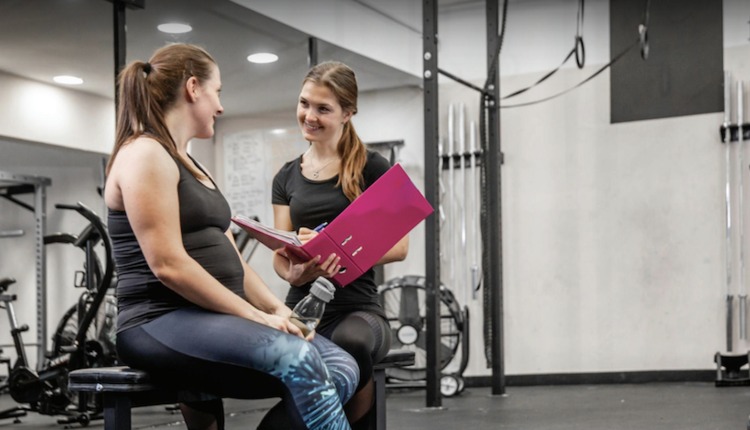Our culture is in a state of crisis with obesity at an all time high, affecting 33% of the population. Besides the obvious challenges of being overweight or obese in our world, when it comes to exercise, plus-sized people have even more obstacles. Since most people who are battling obesity usually have to seek help rather than working out on their own, and because our population is becoming increasingly heavy, there's a good chance you'll soon be training someone who is obese (BMI of 30 or higher) or morbidly obese (weighing at least twice one's ideal weight). With that opportunity comes some changes in the way we typically train, however. The science behind weight loss stays the same, but the logistics of having someone of substantial weight and limited mobility perform everyday exercises becomes a problem.
When working with obese clients, much of your programming must be thrown out or modified. Equipment -- balls, benches, treadmills, bikes and elliptical machines -- has manufacturer-specified weight limits that may exclude your client; make sure you know the limits (generally 300-350 lbs.), or avoid equipment altogether if you're unsure or if your client's mobility is not good enough to use the equipment in the first place. A sturdy bench is often your best bet as it allows you to avoid mat or floor exercises. Most morbidly obese people can't get down on the floor safely, and they certainly can't get back up. Even if you think you're big enough to help them up, chances are you aren't; pulling on a client from the floor is a big risk for injury -- for both you and them.
The client's mobility also affects their ability to jump or stretch. Most heavy people already have knee issues from carrying their girth; they don't need that compounded by a trainer asking them to jump rope. Also recognize that your client may not be as able to stretch or bend over. It seems obvious now, but I hadn't considered that I wouldn't be able to do my typical stretches with her after the workout.
Almost every exercise or stretch must be modified or substituted when working with someone who is morbidly obese. I've listed both substitutions and exercise modifications for heavy people with limited mobility that get back to the basic movements-- without all of the machinery.
Cardio
Cardio is critically important to losing weight. Because the client already carries around a lot of resistance, getting their heart rate elevated and sustained isn't difficult.
Start with short walks around the gym/studio or outside the building, resting when they need to. Who needs a treadmill when walking outside is challenging enough?
If a client can't walk for even short periods, find a chair or bench that will accommodate the client's weight. Place a mobile set of bike petals under a chair for use with feet. Or, put the mobile pedals on the table for the client to use with their hands. Challenge the client to 30 seconds or a minute of hand or food pedaling as fast as they can.
Modified jumping jacks are good whole-body work for almost anyone. Instruct the client to do the same "jumping jack" arms (up overhead and down to the sides), but remove the jumping part by having the client alternate which foot they tap to the side. One foot goes out to a lateral tap and both arms are overhead. Arms come down and feet are together. The other foot goes out to a lateral tap and both arms are overhead. Thirty-second repetitions are generally a good start.
Instruct the client to do low step-ups, using an aerobics-class style step with no risers underneath. Cue them to step up with alternating feet and to make sure their toes are always facing forward and they step with their heel on the step. Most heavy people will turn their toes outward to ensure stability.
Boxing is a great way to get the blood pumping. Teach your client a few basic punches, strap some wraps and boxing gloves on the client, and let them elevate their heart rate by punching your mitts or a heavy bag.
Strength Training
Strength training is vital to increasing muscle mass and metabolism, creating a more functional body and enhancing mobility and balance. However, progression is key. Modify every strength exercise so that it meets obese clients and their level and progress from there.
Squats are undoubtedly one of the most functional exercises and a great way to build leg muscles. Start your obese client with squats to a chair, allowing them to rest in the chair a split second, and then stand up. Progress from there, when ready, to stability ball squats against a wall.
Kettle bell swings are very low impact, utilize multiple muscle groups and can begin with a very low weight swing, if necessary.
Dumbbells, and all the exercises you can do with them, are vital training tools for obese clients. Whether they perform the exercise standing (which is optimal for calorie burn and training for stability) or on a sturdy bench, dumbbells allow you to train specific muscle groups in a safe manner.
Abdominal work is challenging because an obese clients cannot get on the floor. Instead, have them sit, lay back (adjust the bench to 45 degrees if client can't sit up from a totally reclined position), sit up, and stand up from a bench. Add a kettle bell for a modified Turkish Get-up. Or use tubing or bands for standing core work.
Wall push-ups, push-ups against a Smith machine adjustable bar, or push-ups in an upright position on the TRX are a great way to get an obese client started working the chest and arms.
Resistance tubing, cable row machines, or a cable cross machine are a great way to work the back. The client can actually sit to use any of them, although standing is preferable. Be sure to watch for proper alignment.
A yoga block is good to use for strengthening the adductors. Place the block between the knees and have them apply just enough pressure to hold the block in place.
Stretching
Use a table top or a platform to reach the arms out onto to stretch hamstrings. This also is a great stretch for the back. Many obese clients have too much abdominal girth to bend forward more than 90 degrees and they often don't have the balance to raise a leg and stretch the hamstrings.
Assist them in stretching quadriceps. They usually cannot hold onto a foot behind and can't lay on the floor to get a good quadriceps stretch.
Upper body stretches are not usually impeded as much.
Use a platform or bench to manually assist with other stretches.
The goal with the obese population is to help them reconnect with life. Obesity is a lifestyle impediment. Identify specific obstacles, and help your client define activities he would like to do -- things he stopped doing when weight became an issue.
Be one step ahead by anticipating needs, both in the gym and in the world. Look at things through the client's eyes. Size up the physical space and navigate it as if you were the client. How is the furniture placed? How far is the walk to get to the gym? Approach your job with a size-sensitive mind.
Perhaps the most important thing we do for our clients is to try and motivate them to keep moving. Most have been immobile for so long that just moving makes them feel a great sense of accomplishment. So get creative when the obese client walks in your door. Show them how they can change their life one small step at a time!
Shelby Murphy is the retiring editor of PFP media, owner of Empower Personal Fitness Studio, and CEO of My Diet Angel, a program that helps your client lose weight through proper eating while it puts recurring revenue in the pockets of trainers. www.mydietangel.com.













